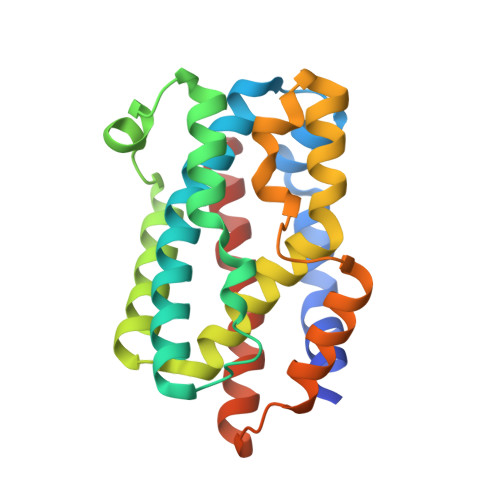Roles of Distal Asp in Heme Oxygenase from Corynebacterium diphtheriae, HmuO: A WATER-DRIVEN OXYGEN ACTIVATION MECHANISM
Matsui, T., Furukawa, M., Unno, M., Tomita, T., Ikeda-Saito, M.(2005) J Biol Chem 280: 2981-2989
- PubMed: 15528205
- DOI: https://doi.org/10.1074/jbc.M410263200
- Primary Citation of Related Structures:
1WNV, 1WNW, 1WNX - PubMed Abstract:
Heme oxygenases found in mammals, plants, and bacteria catalyze degradation of heme using the same mechanism. Roles of distal Asp (Asp-136) residue in HmuO, a heme oxygenase of Corynebacterium diphtheriae, have been investigated by site-directed mutagenesis, enzyme kinetics, resonance Raman spectroscopy, and x-ray crystallography. Replacements of the Asp-136 by Ala and Phe resulted in reduced heme degradation activity due to the formation of ferryl heme, showing that the distal Asp is critical in HmuO heme oxygenase activity. D136N HmuO catalyzed heme degradation at a similar efficiency to wild type and D136E HmuO, implying that the carboxylate moiety is not required for the heme catabolism by HmuO. Resonance Raman results suggest that the inactive ferryl heme formation in the HmuO mutants is induced by disruption of the interaction between a reactive Fe-OOH species and an adjacent distal pocket water molecule. Crystal structural analysis of the HmuO mutants confirms partial disappearance of this nearby water in D136A HmuO. Our results provide the first experimental evidence for the catalytic importance of the nearby water molecule that can be universally critical in heme oxygenase catalysis and propose that the distal Asp helps in positioning the key water molecule at a position suitable for efficient activation of the Fe-OOH species.
Organizational Affiliation:
Institute of Multidisciplinary Research for Advanced Materials, Tohoku University, Katahira, Aoba, Sendai 980-8577, Japan.

















